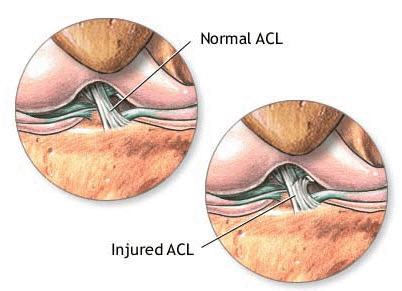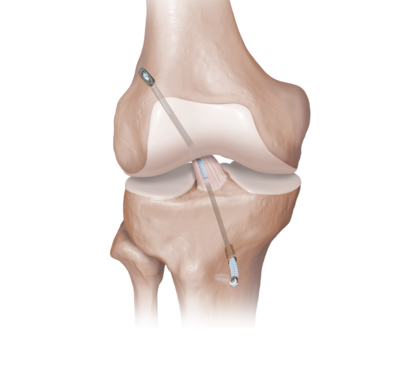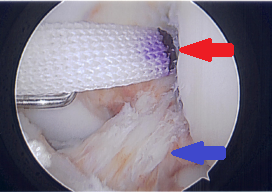ACL Repair
ACL Repair is a revolutionary technique that allows patients to return to function sooner following surgery. Dr. Myers employs the use of a synthetic graft to strengthen the ACL and protect it during the recovery, improving patient outcomes and reducing the chances of re-injury.
What is an ACL? What happens when it’s injured?
The anterior cruciate ligament (ACL) is a piece of elastic tissue within your knee joint that provides stability to your knee, especially during back-and-forth and rotational movements. Damage to the ACL is one of the most common injuries in sports medicine, especially in athletes that participate in fast-paced sports like soccer, football, and basketball. Patients typically describe the moment of injury as a “popping” sensation within their knee, or a sudden feeling of instability. When the damaged ACL goes untreated, the knee may experience decreased stability and a feeling of “giving out” during certain movements. Injury to the ACL, depending on the severity, may require surgical intervention to fix.

ACL tear
## What's the difference between ACL Reconstruction and Repair?

ACL Repair
A reconstruction of the ACL removes the original ligament entirely and replaces it with a new piece of tissue taken from elsewhere on your body. This tissue usually comes from the tendon of your hamstring muscle or the tendon that runs over your knee cap. Once harvested from the tendon site, this tissue is bundled up to match the size and strength of the ACL. The tissue bundle is then anchored in place where the old, damaged ACL was removed. Because this technique requires tissue from another part of a patient’s own body, patients tend to have weakness or pain at the harvest site after surgery. In severe cases of ACL injury, reconstruction may be necessary. However, for moderate or mild injuries, some surgeons may opt to repair the ACL instead.
An ACL repair retains the original ligament and does not require tissue from another part of your body. Instead, the damaged portion of the ACL is pulled back into its original position. Because the ACL still needs time to heal and re-attach itself to the bone, the ACL may benefit from additional protection while it heals. A synthetic graft augment may be used for this purpose.
An ACL repair retains the original ligament and does not require tissue from another part of your body. Instead, the damaged portion of the ACL is pulled back into its original position. Because the ACL still needs time to heal and re-attach itself to the bone, the ACL may benefit from additional protection while it heals. A synthetic graft augment may be used for this purpose.
What is a synthetic graft augment? How does it help my ACL heal?
Once repaired, the ACL needs time to heal and re-attach itself to the bone. To reduce the risk of injury during this critical healing period, a synthetic augment device, also called a synthetic graft augment, may be used to protect the ligament. When repairing an ACL, Dr, Myers uses a synthetic graft augment developed by the Marietta, Georgia-based company
Artelon.
The graft augment is similar to the ACL in terms of strength but is made of a special plastic-like material that is well-tolerated by the body and has elastic properties similar to a regular, healthy ACL. As the repaired ACL is healing, the augment protects the ACL and allows your knee to function from day one. Whenever you put weight on your knee during regular activity, that weight is shared between your repaired ACL and the synthetic graft augment. This reduces the chance of your ACL becoming damaged but still allows it to receive enough use to heal and become stronger. As your repaired ACL grows into place, the synthetic graft slowly degrades until your healed ACL is strong enough to take its place entirely.

Artelon Flexband Graft

The Artelon Flexband Graft (red arrow) is used to strengthen and protect the ACL (blue arrow)